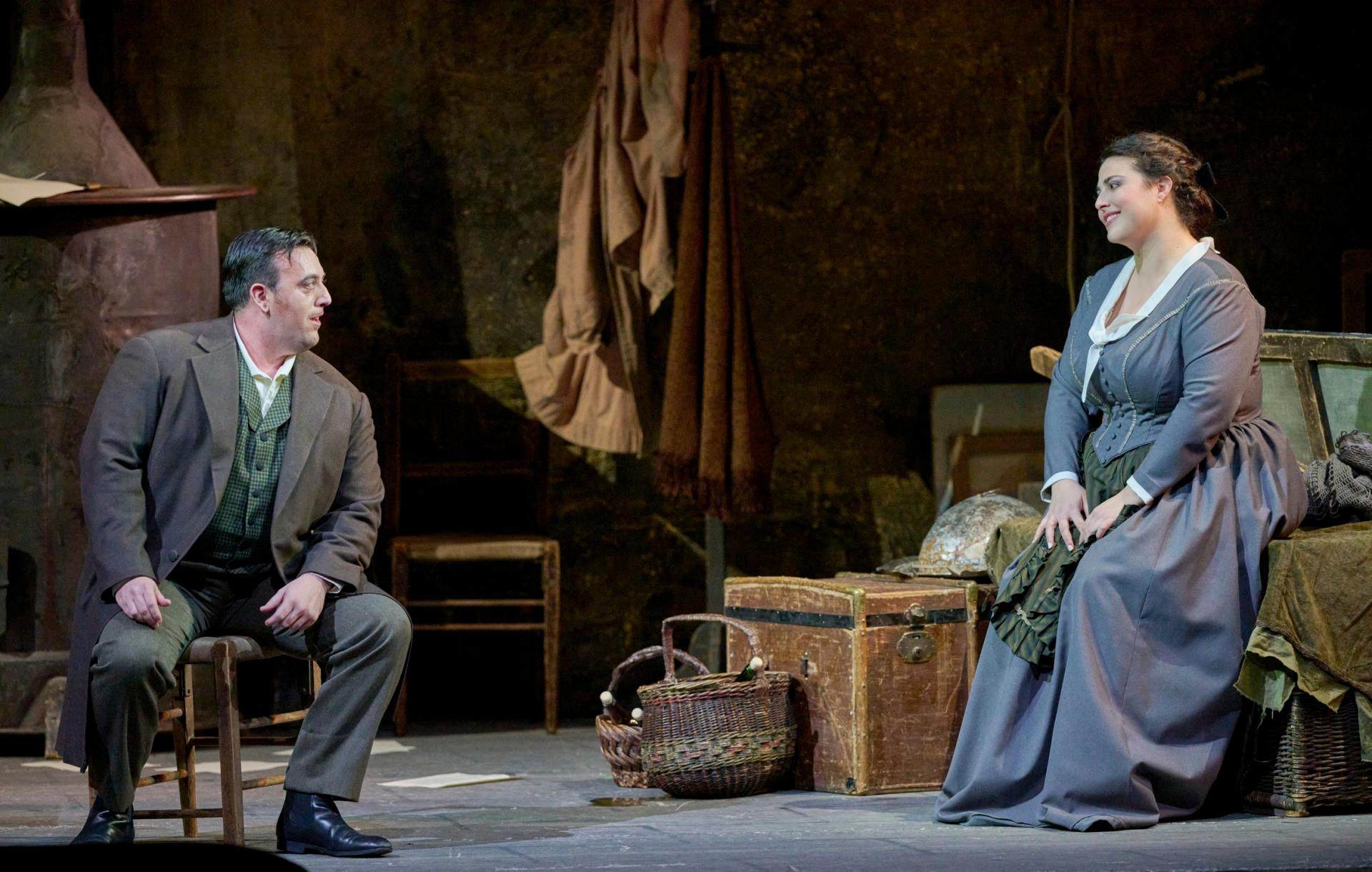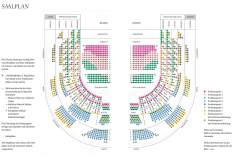La Bohème
Mo | Tu | We | Th | Fr | Sa | Su |
Synopsis
First Act
The Christmas Eve is in the inhabited by four young artists miserable attic is hardly different from other nights:: In the attic Marcel is working on a painting, Rudolf, poet and writer, looking out over the rooftops of Paris. They have no money, they freeze and are still in good spirits. A bundle of manuscripts only heats the oven for a few moments. Collin, in his capacity philosopher, without having achieved anything comes home - the pawn shop was closed. But the fourth, Schaunard, the musician has more luck. He told no one listens to - the food brought to promise you a Merry Christmas. Schaunard but wants it otherwise - on Christmas Eve is assumed. Still in danger: the landlord knocks and calls for the rent. A glass of wine and the friendliness of the artists make him stumble into the trap, winking, he speaks of a love affair, is reason enough for the friends, to show him with well-feigned moral indignation the door.
Rudolph is still to finish an article, go ahead while the others into the Cafe Momus. It knocks: a young woman is outside, she would light the candle extinguished. Tormented by coughing, she collapses. Then, grateful for the aid granted, she wants to go back, but the home is key, not so coincidentally, been lost, the draft can extinguish all the lights. In the darkness, there are hands. Mimi will call them, they can know they embroider flowers ... Outside the call friends. Christmas Eve has lost its gloom.
Second Act
The Latin Quarter: The student quarter of Paris, offers a colorful picture. Crowds of people run through the streets. Rudolph buys Mimì a bonnet of his and invites them to the Café Momus, sets it in front of friends and is looking forward to their admiration. Only Marcel grief, and his grief has a name: Musetta. On the side of an equally ancient and rich gallant she appears to move with the firm intention to involve all the art of seduction. This put forward in public onslaught is not Marcel grew: and an old love is cemented fresh.
Third Act
The barrier d'Enfer: A cloudy morning in February at the customs barrier that separates a Parisian suburb of the city. Laborers, carters, milk, women are allowed to pass, pass by the inn, which is decorated with a half-finished picture Marcel. The wind seems herüberzuwehen Musettes voice. It's cold.
Mimi had a fight with Rudolph, Marcel will teach. Rudolf seems to escape them, they do not know why. Marcel also does not suspect the real reasons, they discovered him, Rudolf: Mimì is dying, she had to live only a short time, and he can not stand, they see suffering. He must endure even more: Mimì has overheard a death sentence, a fit of coughing reveals her presence. Rudolf's love and manage the most difficult: to alleviate distress, to bring peace in the tormented heart. Strange contrast: Marcel and Musetta. Their love seems to seek the dispute.
Fourth Act
In the attic: Three or four months have passed. Marcel and Rudolf have lost their loved ones. Thoughtfully, they sit at work. Where is Musetta, Mimi is where? Can repeat the reckless days of yore?
It almost seems like this: as soon as Schaunard and Collin come with a few poor food, the atmosphere is better, trying to dig out the old gaiety, theater plays, dances, dueling ... Musetta brings in Mimi, Mimi, marked by death. Everything is committed to them, they gratefully acknowledges the friends. Through her eyes Musette and Marcel are combined. Musetta sacrifices her earrings in order to meet the patient's last wish: a muff. And Collin, a philosopher with a heart, put his old coat. Rudolf remains with the dying, and they are alone with their memories.
The Friends are back with their gifts, one last joy for Mimi. Gently she sleeps over.
ACT 1 & 2 - 60 MIN
INTERMISSION - 25 MIN
ACT 3 & 4 - 60 MIN
Program and cast
Rodolfo: Saimir Pirgu; Liparit Avetisyan*
Mimì: Elbenita Kajtazi; Ailyn Pérez*
Marcello: Leonardo Neiva; Clemens Unterreiner*
Schaunard: Martin Häßler
Colline: Ilja Kazakov; Peter Kellner*
Musetta: Anna Bondarenko; Maria Nazarova*
Musical Direction: Giedre Šlekytė; Lorenzo Passerini*
Direction and Stage: Franco Zeffirelli
Costumes: Marcel Escoffier
*January 24, 2025; January 26, 2025; January 29, 2025; February 3, 2025
Vienna State Opera
Public Transport
Subway lines: U1, U2, U4
Trams: 1, 2, D, J, 62, 65
Buses: 59A
Local Railway: Badner Bahn
Stops: Karlsplatz / Opera
Taxi stands are available nearby.
Parking
Parking is only € 6, - for eight hours!
The Wiener Staatsoper and the ÖPARK Kärntner Ring Garage on Mahlerstraße 8, under the “Ringstraßengalerien”, offer the patrons of the Vienna State Opera a new, reduced parking fee. You can park in the Kärntner Ring Garage for up to 8 hours and pay only a flat fee of € 6, -. Just validate your ticket at one of the discount machines inside the Wiener Staatsoper. The normal rate will be charged for parking time greater than 8 hours. The validation machines can be found at the following coat checks: Operngasse, Herbert von Karajan-Platz, and the right and left and balcony galleries.
Important: In order to get the discount, please draw a ticket and do not use your credit card when entering the garage!
After devaluing your ticket in the Wiener Staatsoper you can pay comfortably by credit card or cash at the vending machines.
The machines accept coins and bills up to 50.- Euro. Parking time longer than 8 hours will be charged at the normal rate.
History
The structure of the opera house was planned by the Viennese architect August Sicard von Sicardsburg, while the inside was designed by interior decorator Eduard van der Nüll. It was also impacted by other major artists such as Moritz von Schwind, who painted the frescoes in the foyer, and the famous "Zauberflöten" (“Magic Flute”) series of frescoes on the veranda. Neither of the architects survived to see the opening of ‘their’ opera house: the sensitive van der Nüll committed suicide, and his friend Sicardsburg died of a stroke soon afterwards.
On May 25, 1869, the opera house solemnly opened with Mozart's Don Giovanni in the presence of Emperor Franz Joseph and Empress Elisabeth.
The popularity of the building grew under the artistic influence of the first directors: Franz von Dingelstedt, Johann Herbeck, Franz Jauner, and Wilhelm Jahn. The Vienna opera experienced its first high point under the direction of Gustav Mahler. He completely transformed the outdated performance system, increased the precision and timing of the performances, and also utilized the experience of other noteworthy artists, such as Alfred Roller, for the formation of new stage aesthetics.
The years 1938 to 1945 were a dark chapter in the history of the opera house. Under the Nazis, many members of the house were driven out, pursued, and killed, and many works were not allowed to be played.
On March 12, 1945, the opera house was devastated during a bombing, but on May 1, 1945, the “State Opera in the Volksoper” opened with a performance of Mozart's THE MARRIAGE OF FIGARO. On October 6, 1945, the hastily restored “Theaters an der Wien” reopened with Beethoven's FIDELIO. For the next ten years the Vienna State Opera operated in two venues while the true headquarters was being rebuilt at a great expense.
The Secretary of State for Public Works, Julius Raab, announced on May 24, 1945, that reconstruction of the Vienna State Opera would begin immediately. Only the main facade, the grand staircase, and the Schwind Foyer had been spared from the bombs. On November 5, 1955, the Vienna State Opera reopened with a new auditorium and modernized technology. Under the direction of Karl Böhm, Beethoven’s FIDELIO was brilliantly performed, and the opening ceremonies were broadcast by Austrian television. The whole world understood that life was beginning again for this country that had just regained its independence.
Today, the Vienna State Opera is considered one of the most important opera houses in the world; in particular, it is the house with the largest repertoire. It has been under the direction of Dominique Meyer since September 1, 2010.

 EN
EN DE
DE IT
IT FR
FR ES
ES RU
RU JP
JP RO
RO
 Seating plan
Seating plan